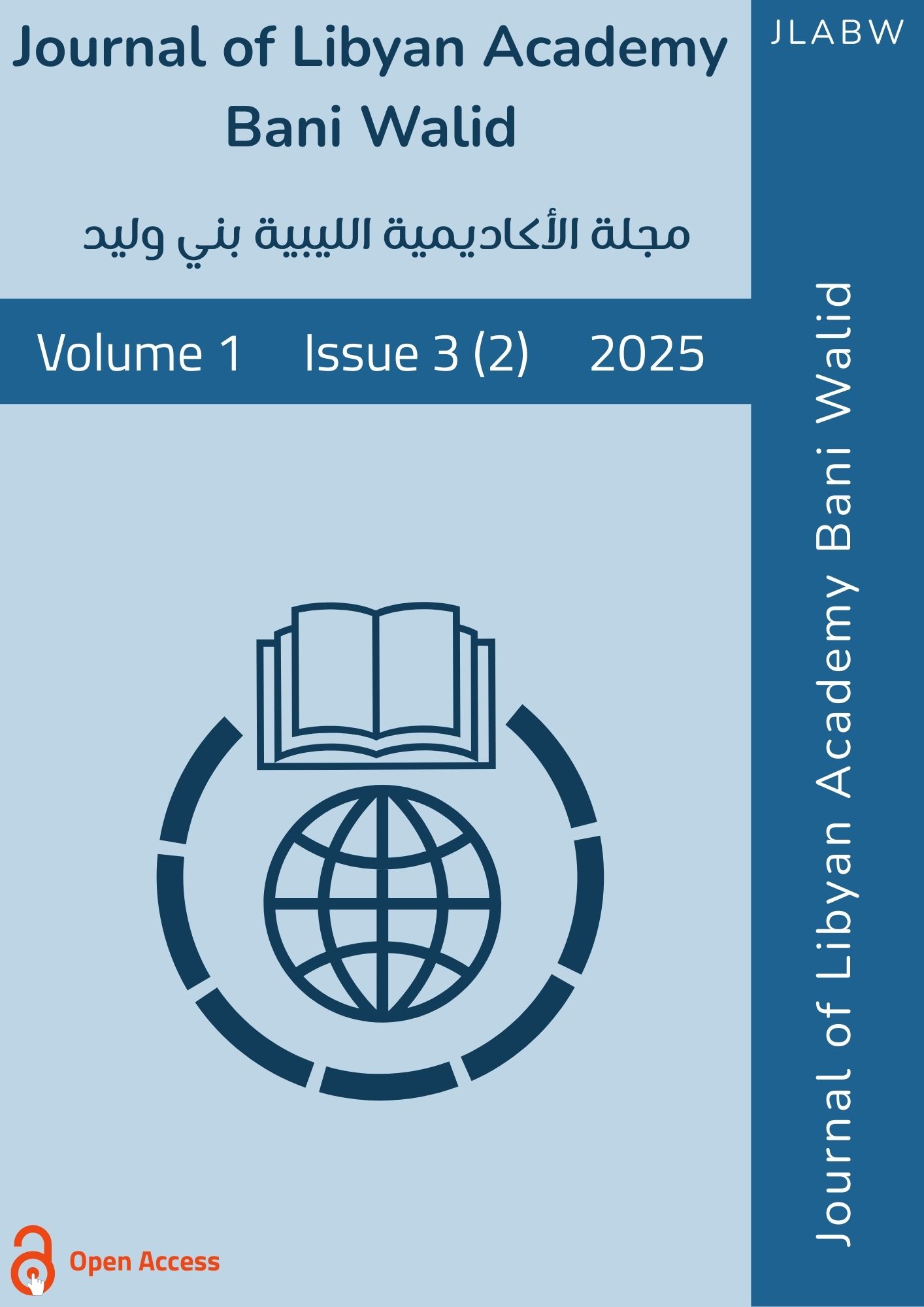عزل والتعرف على البكتيريا المسببة للالتهابات المسالك البولية في لدي النساء الحوامل في مدينة ترهونة
DOI:
https://doi.org/10.61952/jlabw.v1i3.235الكلمات المفتاحية:
التهابات المسالك البولية، النساء الحوامل، ترهونة، العزل البكتيري، مقاومة المضادات الحيويةالملخص
هدفت هذه الدراسة إلى عزل وتشخيص البكتيريا المسببة لالتهابات المسالك البولية لدى النساء الحوامل في مدينة ترهونة، ليبيا. جُمعت (72) عينة بول من الحوامل وتم تحليلها باستخدام طرق الزرع البكتيري، الاختبارات الكيميائية الحيوية، وتقنية MALDI-TOF عند توفرها. أظهرت النتائج أن المكورات العنقودية الذهبية (Staphylococcus aureus) كانت الأكثر شيوعًا بنسبة (45.5%)، تلتها الإشريكية القولونية (E. coli) بنسبة (20%)، ثم الكليبسيلا بنسبة (14.5%)، بالإضافة إلى أنواع أخرى مثل المعويات، البروتيوس، والعقديات. كما بيّنت النتائج أن كلًا من النتروفورانتوين والسيبروفلوكساسين أظهرا أعلى فعالية ضد البكتيريا المعزولة، في حين سُجلت معدلات مقاومة مرتفعة تجاه الأموكسيسيلين-كلافولانيك و الترايميثوبريم-سلفاميثوكسازول. وتؤكد هذه النتائج على أهمية الفحص الدوري لعينات البول، وترشيد استخدام المضادات الحيوية، واستمرار المراقبة لمعدلات المقاومة البكتيرية. خلصت الدراسة إلى أن التهابات المسالك البولية لا تزال تمثل مشكلة صحية شائعة أثناء الحمل، مما يتطلب تشخيصًا دقيقًا، علاجًا مناسبًا، وتطبيق إجراءات وقائية لتقليل المضاعفات التي قد تؤثر على الأم والجنين
المراجع
• Abubakar, E. M. (2021). Bacterial pathogens associated with urinary tract infection among pregnant women in Maiduguri, Nigeria. Annals of Clinical Microbiology and Antimicrobials, 20, 32.
• Ahmad, S., et al. (2020). Rising prevalence of multidrug-resistant uropathogenic bacteria in pregnant women. Journal of Taibah University Medical Sciences, 16(1), 102–111.
• Ali, M. A., et al. (2024). Phenotypic and genotypic characterization of uropathogenic Escherichia coli isolated from pregnant women in Egypt. Microbial Pathogenesis, 183, 106144.
• Al-Khalidi, R. (2023). A review of urinary tract infections among pregnant women in Iraq: prevalence, risk factors, and antimicrobial resistance (2000–2023). Iraqi Journal of Medical Sciences.
• Al-Nasser, A., Mohammed, D., & Al-Ibrahim, W. (2021). Isolation and identification of bacterial strains from urine samples of pregnant women at Tishreen University Hospital. Tartous University Scientific Journal.
• Al-Taima, Z. (2024). Evaluation of the antibacterial effect of green nanocomposite on urinary tract infection bacteria in pregnant women [Master’s thesis, University of Karbala].
• El-Mahdi, A. (2019). Isolation and antimicrobial susceptibility of uropathogens among pregnant women at Benghazi Medical Center, Libya. Libyan Medical Journal.
• Flores-Mireles, A. L., Walker, J. N., Caparon, M., & Hultgren, S. J. (2015). Urinary tract infections: Epidemiology, mechanisms of infection and treatment options. Nature Reviews Microbiology, 13(5), 269–284.
• Ghahfarokhi, M. S., et al. (2023). Isolation and molecular detection of uropathogens in pregnant women: A comparative study of conventional and molecular methods. Journal of Infection and Public Health, 16(1), 88–95.
• McCormick, T., Ashe, R. G., & Kearney, P. M. (2008). Urinary tract infection in pregnancy. Obstetrics and Gynaecology, 10, 156–162.
• Mensah, P., et al. (2025). Risk factors and antimicrobial resistance of urinary tract infections in pregnant women in Ghana. African Journal of Reproductive Health.
• Mwaka, A. D., et al. (2021). Prevalence and antimicrobial susceptibility of bacterial uropathogens isolated from pregnant women with urinary tract infections in northern Uganda. Infection and Drug Resistance, 14, 1239–1247.
• Osman, H., et al. (2024). Bacterial profile and antibiotic susceptibility patterns of urinary tract infections among pregnant women in Sudan. Journal of Infection in Developing Countries, 18(3), 215–224.
• Salem, F. (2021). Prevalence and antimicrobial resistance of urinary tract infection pathogens among pregnant women in Eastern Libya. Eastern Mediterranean Health Journal.
• Shiblawi, K. K. (2022). Molecular detection of antibiotic resistance genes among bacteria causing urinary tract infections in pregnant women [Master’s thesis, University of Kufa].
• Tadesse, B. T., et al. (2020). Bacterial profile and drug susceptibility among urinary tract infection suspected pregnant women in Ethiopia: A cross-sectional study. BMC Infectious Diseases, 20, 613.
• Tadesse, W., et al. (2016). Asymptomatic bacteriuria and antimicrobial susceptibility among pregnant women in Ethiopia. BMC Pregnancy and Childbirth, 16, 99.
• Turay, A. A., & Emeka, M. (2022). Isolation and identification of uropathogens in pregnant women attending antenatal clinics in Lagos, Nigeria. African Journal of Clinical and Experimental Microbiology, 23(1), 24–31.
• UK Health Security Agency. (2023). Urinary tract infection (UTI). RCGP Learning.






